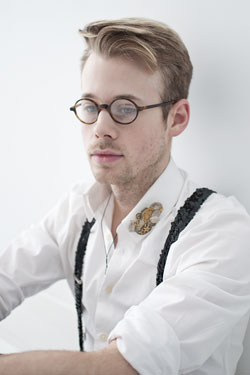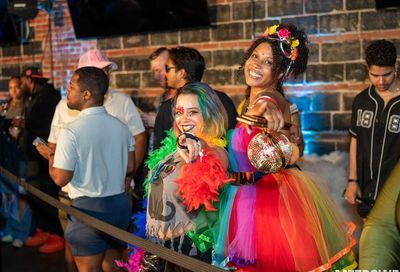Drawn Together
With their queer artists' collective Boys Be Good, Christopher Cunetto and Jason Edward Tucker are finding that there's strength – and artistry – in numbers

Boys be Good: Cunetto
(Photo by Todd Franson)
MW: Which is why everybody is not really an artist. So, my big question: What is it with gay artists? Why do they seem fixated on putting penises in virtually everything that you see?
CUNETTO: Throughout the history of art, the female is something that is totally accepted. And I think that for a lot of gay male artists you want to say, “I’m trained in art and the nude body is the nude body. And the stories that I’m telling are from my perspective. I’m telling stories that I know.” And if I’m using the conventions that draw on classical art, the nude is a huge part of that.
And culturally in cinema, in art, even in our television shows, men are more covered up, they’re more disguised, emotionally more covered up, physically more covered up. Women are the ones who are supposed to expose themselves. And so, it’s not just an obsession with penises or with sex or sexuality, but it’s really baring your physical being. It’s as emotional and psychological and mental as it is physical. So that act – although it’s really pigeonholed into, “Oh, just another gay artist” – it’s really, really meaningful.
TUCKER: A lot of it has to do with context. The question has been asked by the last 50 years of feminism, why is it the nude form of a female has been so readily accepted for the past 2,000 years of art history. Male artists creating female work is seen as, “Oh they’re just objectifying that female. Yet when it’s reclaimed by a female artist and becomes an obsession of a female artist to create a nude form, it becomes something entirely different because of the context of the artist creating the work.
Use of the male figure is a way of reclaiming the male figure – and not just reclaiming it from a male standpoint, but reclaiming the male figure from a homosexual standpoint, like, ”I’m gonna put it in your face.” I might show you a dick in there – I’m just trying to reclaim exactly what I feel has not been represented.
MW: Do you think you’re also creating art that you’re personally interested in? As gay men, it makes sense you’d be more drawn to the male body.
CUNETTO: It begs the question, at what point does your sexuality inform your work as opposed to the other way around?
TUCKER: Sexuality is so tied into human nature that it becomes the question of are we obsessed with our subjects, are we glorifying them, or are we objectifying them?
CUNETTO: This is a really big question of the collective, because there is so much artwork that is gay art and is sexual and is definitionally pornographic because it is meant to excite. But there is art that is from a queer prospective that involves the male nude that’s about a whole lot more. And because the culture – our culture – isn’t used to seeing things this way, those things are lumped together.
We have to challenge the pigeonholing that queer artists experience. Whether it’s a lesbian making nude females images or gay men making nude male images, those things have to be challenged, because in terms of art history and contemporary art, there’s a lot more academically that you can bring into them that may be about sexuality but is not necessarily meant as an end to be pornography.
MW: What if a gay artist doesn’t want to draw a naked guy?
CUNETTO: A lot haven’t.
TUCKER: A lot of our stuff is non-representational. It just becomes a mass or a form or a shape or gender queer or something that is not supposed to have an assigned gender.
MW: Last question. I’ll start with you, Jason. One hundred years in the future, how do you want to be remembered as an artist?
TUCKER: Hmmm. That’s a hard question. As an advocate for queer culture and art. I’d like to be remembered more so for what I did on a communal scale than what I did for personal artistic identity.
MW: Chris, what about you?
CUNETTO: I want to be remembered for making works that move people, for doing things that move people, changes their minds, helps them learn. I want to be remembered as someone who was of his time and reflective of his time. There are some artists who kind of just live and are looked back on as examples of what the world was like and how tumultuous it was. But for me that process is active and purposeful and ongoing. I want to leave behind residue of my engagement with the world. And I hope that my art reflects that engagement and that desire, and that my efforts and engagement with the community and my work and organizing effected some kind of change.
Debitum Naturae will be on display from June 5 to July 17 at Arts@1830 at 1830 14th St. NW. The opening reception is Tuesday, June 5, from 6 to 8 p.m. and is free and open to the public. A performance-night fundraiser for the It Gets Better Project, is Tuesday, June 19, from 6 to 9 p.m. Reserved seating is $15 online at boysbegood.com or a suggested donation of $10 at the door for standing room. Visit boysbegood.com or call 202-643-2699.
Support Metro Weekly’s Journalism
These are challenging times for news organizations. And yet it’s crucial we stay active and provide vital resources and information to both our local readers and the world. So won’t you please take a moment and consider supporting Metro Weekly with a membership? For as little as $5 a month, you can help ensure Metro Weekly magazine and MetroWeekly.com remain free, viable resources as we provide the best, most diverse, culturally-resonant LGBTQ coverage in both the D.C. region and around the world. Memberships come with exclusive perks and discounts, your own personal digital delivery of each week’s magazine (and an archive), access to our Member's Lounge when it launches this fall, and exclusive members-only items like Metro Weekly Membership Mugs and Tote Bags! Check out all our membership levels here and please join us today!






















